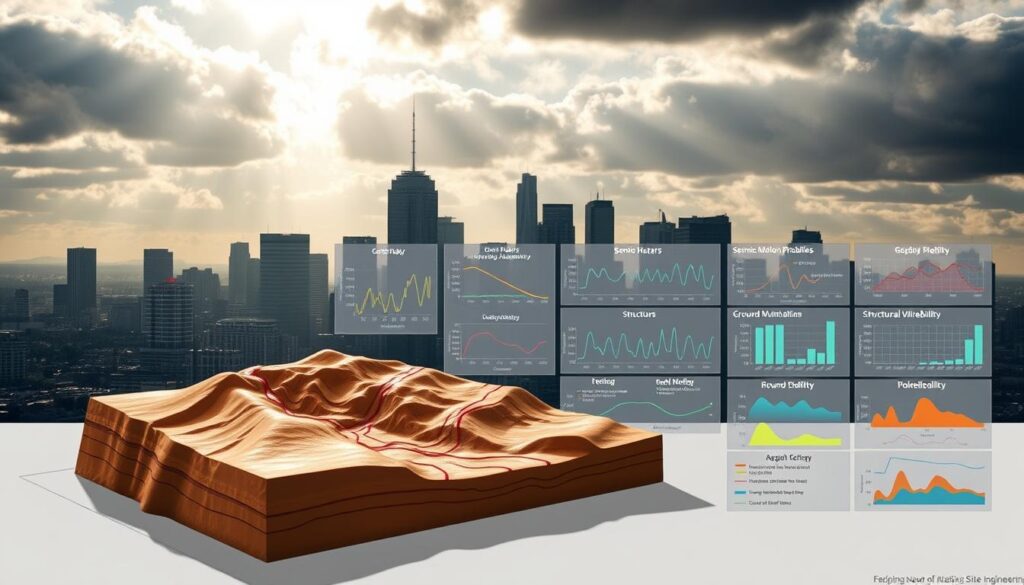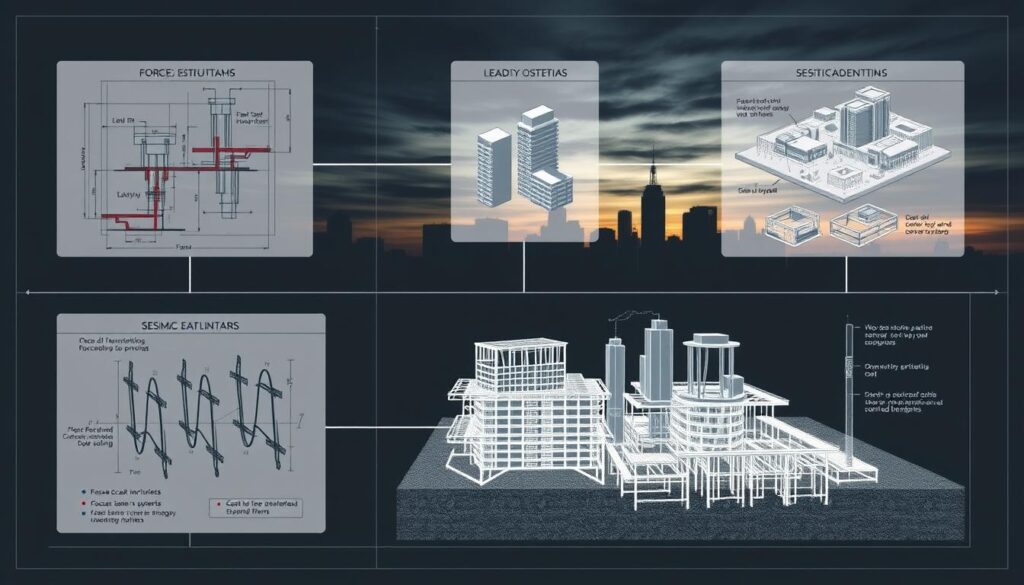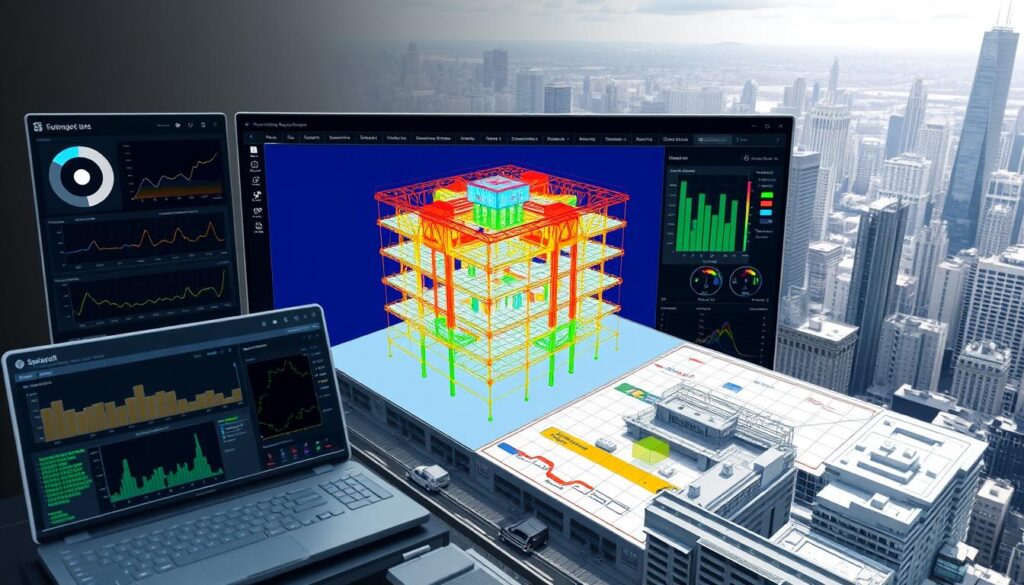Earthquakes can strike without warning, causing widespread destruction and loss of life. The importance of earthquake-resistant structures cannot be overstated, as they are crucial in saving lives and reducing damage during seismic events.
Seismic design engineering plays a vital role in creating buildings and infrastructure that can withstand earthquakes. This involves a multi-hazard approach, performance-based requirements, and collaboration among the design team.
By understanding seismic risk assessment and implementing effective seismic design strategies, we can significantly reduce the impact of earthquakes on communities.
Key Takeaways
- Earthquake-resistant structures are critical in minimizing damage and loss of life.
- Seismic design involves a multi-hazard approach and collaboration.
- Effective seismic risk assessment is key to protecting structures.
- Seismic design engineering saves lives and reduces economic loss.
- Collaboration among the design team is essential for successful seismic design.
Introduction to Seismic Design Engineering
Seismic design engineering is a critical field that focuses on creating structures that can withstand earthquakes and minimize damage to buildings and infrastructure. This discipline is essential for ensuring the safety of populations in earthquake-prone areas.
What is Seismic Design Engineering?
Seismic design engineering involves applying engineering principles to design and construct buildings and other structures that can resist seismic forces. It requires a deep understanding of how different materials and structural systems respond to earthquake-induced motions. A seismic engineering consultant plays a crucial role in this process by providing expert advice on how to meet seismic design criteria.
Importance of Earthquake Resilience
Earthquake resilience is vital for communities located in seismically active regions. By designing structures that can withstand earthquakes, seismic design engineering helps to protect human life, reduce economic losses, and maintain the functionality of critical infrastructure. Seismic performance evaluation is a key aspect of this process, as it involves assessing how well a structure can perform during an earthquake.
For more information on structural engineering practices, you can visit https://worldcivilsociety.com/structural-engineering-2/.
Historical Context of Seismic Engineering
The field of seismic engineering has a rich history that spans several decades. From early attempts to understand earthquake phenomena to the development of sophisticated design codes and analysis techniques, seismic engineering has evolved significantly. Understanding this historical context is essential for appreciating the advancements that have been made and the challenges that still need to be addressed.
Understanding Earthquake Dynamics
Understanding the complexities of earthquake dynamics is essential for developing effective seismic design strategies. Earthquake dynamics involve the study of seismic waves and their impact on structures, which is crucial for designing buildings that can withstand earthquakes.
Types of Earthquakes
Earthquakes can be categorized into several types based on their origin and characteristics. The main types include tectonic, volcanic, collapse, and human-induced earthquakes. Tectonic earthquakes are the most common and occur due to the movement of tectonic plates.
- Tectonic earthquakes: Result from the movement of the Earth’s crust.
- Volcanic earthquakes: Associated with volcanic activity.
- Collapse earthquakes: Caused by the collapse of underground caverns.
- Human-induced earthquakes: Triggered by human activities such as injection of fluids into the ground.
How Earthquakes Affect Structures
Earthquakes affect structures by imposing seismic forces that can cause damage or collapse. The severity of the impact depends on factors such as the magnitude of the earthquake, the distance from the epicenter, and the design of the structure.
Structures that are not designed or retrofitted for seismic activity are particularly vulnerable. Seismic design software and structural dynamics analysis play a critical role in assessing and enhancing the seismic resilience of structures.

Measuring Seismic Activity
Measuring seismic activity is crucial for understanding earthquake dynamics and for seismic design engineering. Seismic activity is measured using seismographs, which record the ground motions caused by earthquakes.
| Measurement Tool | Purpose | Significance in Seismic Design |
|---|---|---|
| Seismographs | Record ground motions | Provides data for seismic hazard assessment |
| Accelerometers | Measure acceleration of ground motion | Essential for designing structures to withstand seismic forces |
| Seismic hazard maps | Map seismic hazard zones | Guides seismic code compliance and design requirements |
Accurate measurement and analysis of seismic activity are vital for ensuring that structures are designed to comply with seismic codes and to resist earthquake forces effectively.
Key Principles of Seismic Design
Seismic design engineering encompasses various principles aimed at minimizing earthquake damage. Effective seismic design is crucial for ensuring that structures can withstand earthquakes and protect the lives of occupants.
Load Resistance Frameworks
Load resistance frameworks are critical in seismic design as they help structures withstand the forces generated by earthquakes. These frameworks are designed to absorb and distribute the seismic forces, reducing the risk of structural failure. According to
“Seismic design criteria are essential for ensuring that buildings can resist earthquake forces.”
The use of advanced materials and designs has significantly improved the load resistance capabilities of modern structures.
Key elements of load resistance frameworks include:
- Robust foundation systems
- Strong column-weak beam designs
- Effective bracing systems
Damping Technologies
Damping technologies play a vital role in reducing the impact of seismic forces on structures. These technologies help to dissipate the energy generated by earthquakes, thereby minimizing damage. Advanced damping systems are being increasingly used in seismic design to enhance the resilience of buildings.
The incorporation of damping technologies into seismic design can significantly improve a structure’s ability to withstand earthquakes. As noted by experts, “Damping technologies are crucial for enhancing seismic performance evaluation.”
Flexibility and Rigidity Balance
Achieving a balance between flexibility and rigidity is essential in seismic design. Structures need to be flexible enough to absorb seismic forces but rigid enough to maintain their integrity. This balance is critical for ensuring that buildings can withstand earthquakes without collapsing.
The balance between flexibility and rigidity is achieved through careful design and the use of appropriate materials. Seismic retrofitting solutions often involve modifying existing structures to improve their flexibility and rigidity.
Regulations and Standards in Seismic Design
The importance of regulations and standards in seismic design cannot be overstated, as they provide the framework for constructing earthquake-resistant buildings. These guidelines are crucial for ensuring that structures can withstand seismic forces and protect the lives of occupants.

Overview of Building Codes
Building codes are a set of rules that specify the minimum requirements for the design, construction, and inspection of buildings. In the context of seismic design, building codes play a vital role in dictating how structures should be built to resist earthquake forces. Compliance with these codes is essential for ensuring that buildings can withstand seismic activity.
A seismic engineering consultant typically works within these codes to design structures that meet or exceed the minimum requirements. This involves a deep understanding of the local building codes and the ability to apply them effectively in design.
International Building Code (IBC)
The International Building Code (IBC) is one of the most widely adopted building codes in the United States. It provides comprehensive guidelines for the design and construction of buildings, including provisions for seismic design. The IBC outlines the seismic design criteria that must be followed to ensure that structures are earthquake-resistant.
One of the key aspects of the IBC is its classification of buildings based on occupancy and risk. This classification system helps determine the level of seismic design required for a particular structure, ensuring that high-risk buildings are designed with more stringent seismic criteria.
American Society of Civil Engineers (ASCE) Guidelines
The American Society of Civil Engineers (ASCE) also provides critical guidelines for seismic design through its standards, notably ASCE 7-16. These guidelines offer detailed provisions for seismic design, including methods for determining seismic forces, designing structural systems, and ensuring that structures can deform without collapsing during an earthquake.
Compliance with ASCE guidelines is often seen as a benchmark for seismic code compliance. Engineers and architects rely on these standards to ensure that their designs meet the necessary criteria for earthquake resistance, thereby enhancing the safety of building occupants.
In conclusion, regulations and standards are fundamental to seismic design, providing the necessary framework for constructing buildings that can withstand earthquakes. By adhering to building codes like the IBC and guidelines from organizations such as ASCE, engineers can ensure that structures are designed with the appropriate level of seismic resistance.
Materials Used in Seismic Engineering
Materials play a vital role in seismic design, influencing a structure’s ability to withstand seismic forces. The selection of appropriate materials is crucial for ensuring the resilience and durability of buildings during earthquakes.
Steel Versus Concrete Structures
The debate between using steel or concrete in seismic engineering is ongoing. Steel structures are known for their ductility and ability to deform without collapsing, making them suitable for seismic-resistant design. On the other hand, concrete structures offer high strength and durability. The choice between the two often depends on the specific requirements of the project, including factors like cost, architectural design, and local building codes.
A comparison of the two materials reveals distinct advantages:
- Steel is more ductile and can absorb seismic energy better.
- Concrete provides higher compressive strength and better resistance to fire.
Innovations in Building Materials
Recent advancements in material science have led to the development of innovative materials for seismic engineering. For instance, sustainable building materials are being increasingly used, offering not only seismic resilience but also environmental benefits. These materials include advanced composites and high-performance concrete.
Some of the key innovations include:
- High-performance fiber-reinforced cementitious composites.
- Shape memory alloys that can return to their original shape after deformation.
Role of Reinforcement
Reinforcement is a critical aspect of seismic design, enhancing the tensile strength of materials like concrete. The use of rebar and other reinforcement techniques improves the overall performance of structures during seismic events. Proper reinforcement ensures that the structure can withstand the stresses and strains imposed by earthquakes.
Site Assessment in Seismic Engineering
Seismic design engineering heavily relies on thorough site assessments to ensure the stability of structures during earthquakes. A comprehensive site assessment involves evaluating the geotechnical properties of the site, which is crucial for designing structures that can withstand seismic forces.
Geotechnical Studies
Geotechnical studies are fundamental to understanding the soil and rock properties at a construction site. These studies help engineers assess the site’s potential for liquefaction, landslides, and other hazards that could impact the structure’s integrity during an earthquake. By conducting thorough geotechnical investigations, engineers can determine the appropriate foundation design and other seismic design criteria.
For more detailed information on geotechnical studies, you can refer to resources such as the American Society of Civil Engineers (ASCE) guidelines, which provide comprehensive insights into seismic design and geotechnical engineering practices.
Soil Analysis Techniques
Soil analysis techniques are vital for understanding the dynamic behavior of soils under seismic loading. Techniques such as seismic refraction, electrical resistivity tomography, and borehole logging help engineers characterize the soil’s properties and predict its response to seismic activity. Accurate soil analysis is essential for seismic risk assessment and for developing effective seismic design criteria.

Site Classifications in Design
Site classifications play a significant role in seismic design as they categorize sites based on their soil and rock properties. These classifications influence the seismic design coefficients and the overall design strategy for a structure. By classifying the site correctly, engineers can ensure that the structure is designed to withstand the expected seismic forces, thereby enhancing its seismic performance evaluation.
Effective site assessment and classification enable engineers to make informed decisions about the design and construction of structures, ultimately contributing to the resilience of communities against seismic events.
Designing for Performance-Based Outcomes
Performance-based design is revolutionizing the field of seismic engineering by focusing on achieving specific performance objectives during seismic events. This approach ensures that structures are not only designed to withstand earthquakes but also to maintain their functionality and safety post-event.
Performance Objectives in Seismic Events
Setting clear performance objectives is crucial in seismic design. These objectives define the desired behavior of a structure during an earthquake, including factors like occupancy, life safety, and collapse prevention. By establishing these objectives, engineers can tailor their designs to meet specific needs, enhancing the resilience of structures.
For instance, a hospital might be designed with a higher performance objective to ensure it remains operational after an earthquake, whereas a residential building might focus on life safety and collapse prevention. Understanding these objectives is key to effective seismic risk assessment and mitigation.
Risk Assessment and Mitigation
Conducting thorough risk assessments is a critical step in performance-based seismic design. This involves analyzing the potential seismic hazards a structure might face and evaluating its vulnerability. By using advanced seismic design software, engineers can simulate various earthquake scenarios to predict how a structure will respond.
Mitigation strategies are then developed based on these assessments. These might include enhancing the structural integrity, implementing damping technologies, or using base isolation systems to reduce the impact of seismic forces on the structure.
Case Studies in Performance-Based Design
Several case studies demonstrate the effectiveness of performance-based seismic design. For example, the retrofitting of historic buildings using performance-based design principles has shown significant improvements in their seismic resilience. Another case involves the design of new structures with advanced damping systems, which have performed exceptionally well during seismic events.
These case studies highlight the benefits of adopting a performance-based approach, including enhanced safety, reduced damage, and faster recovery times post-earthquake. As seismic engineering continues to evolve, the integration of innovative technologies and design methodologies will further improve performance-based outcomes.
Advanced Seismic Design Techniques
As earthquakes continue to pose a threat to structures worldwide, advanced seismic design techniques offer a promising solution. These techniques are crucial in enhancing the resilience of buildings and ensuring they can withstand seismic forces.
Base Isolation Systems
Base isolation systems are a significant advancement in seismic design, allowing buildings to move independently of the ground during an earthquake. This is achieved through the use of isolators that decouple the structure from the earth, reducing the transfer of seismic energy. Base isolation is particularly effective for structures that are sensitive to seismic activity or are located in areas with high seismicity.

Energy Dissipation Devices
Energy dissipation devices are another critical component of advanced seismic design. These devices absorb the energy generated by seismic activity, reducing the impact on the structure. Techniques include the use of dampers that can be integrated into the building’s design to absorb seismic energy, thereby minimizing damage.
Using Technology for Enhanced Design
The integration of technology in seismic design has revolutionized the field. Advanced software and modeling techniques enable engineers to simulate seismic events and assess the performance of structures under various conditions. This allows for more informed design decisions and the optimization of seismic retrofitting solutions. Structural dynamics analysis plays a key role in this process, enabling the precise calculation of a structure’s response to seismic forces.
By leveraging these advanced seismic design techniques, engineers can significantly enhance the seismic resilience of structures, ultimately saving lives and reducing economic losses. The application of seismic design criteria and the use of advanced technologies are critical in achieving these outcomes.
Structural Analysis for Earthquake Resistance
Advanced structural analysis is key to designing earthquake-resistant buildings. This process involves evaluating how structures respond to seismic forces, ensuring they can withstand earthquakes without collapsing.
There are several techniques used in structural analysis for earthquake resistance. These include:
- Finite Element Analysis (FEA)
- Dynamic Response Analysis
- Software Tools for Seismic Analysis
Finite Element Analysis
Finite Element Analysis is a computational method used to determine the behavior of complex structures under various loads, including seismic forces. By dividing the structure into smaller elements, engineers can simulate how different parts of the building will react during an earthquake.
Key benefits of FEA include:
- Detailed stress analysis
- Ability to model complex geometries
- Simulation of various loading conditions
Dynamic Response Analysis
Dynamic Response Analysis involves studying how structures respond to dynamic loads, such as those generated by earthquakes. This method helps engineers understand the dynamic behavior of buildings, including their natural frequencies and mode shapes.
The importance of Dynamic Response Analysis lies in its ability to:
- Predict structural response to seismic activity
- Identify potential failure modes
- Optimize structural design for better seismic performance
Software Tools for Seismic Analysis
Several software tools are available for seismic analysis, each with its unique capabilities. Some popular tools include:
- ETABS
- SAP2000
- OpenSees
These software tools enable engineers to perform detailed seismic analyses, including Finite Element Analysis and Dynamic Response Analysis, to ensure that structures are designed to be earthquake-resistant.
Retrofitting Existing Structures
Retrofitting existing structures is a critical step in enhancing seismic resilience. As the number of older buildings continues to be a concern in earthquake-prone areas, the need for effective retrofitting solutions has become more pressing.

Significance of Retrofitting
Retrofitting is essential for reducing the vulnerability of existing structures to seismic activity. By enhancing the structural integrity of buildings, retrofitting can significantly decrease the risk of damage or collapse during an earthquake. This not only saves lives but also reduces the economic impact of seismic events.
A key aspect of retrofitting is the seismic risk assessment, which involves evaluating the potential risks associated with a structure and identifying the necessary measures to mitigate these risks. This process is crucial for determining the most effective retrofitting strategies.
Common Retrofitting Techniques
Several retrofitting techniques are commonly used to enhance seismic resistance:
- Adding structural reinforcement, such as steel bracing or concrete jackets, to improve a building’s ability to withstand seismic forces.
- Implementing base isolation systems to decouple the building from the ground, thereby reducing the transmission of seismic energy.
- Using energy dissipation devices to absorb seismic energy and minimize structural damage.
These techniques are often used in conjunction with one another to achieve optimal results. The choice of technique depends on various factors, including the type of structure, its condition, and the seismic design criteria applicable to the area.
Cost-Benefit Analysis of Retrofitting
Conducting a cost-benefit analysis is a crucial step in the retrofitting process. It involves weighing the costs of retrofitting against the potential benefits, such as reduced damage and loss of life. This analysis helps stakeholders make informed decisions about whether to retrofit a structure and which techniques to use.
| Retrofitting Technique | Cost | Benefit |
|---|---|---|
| Structural Reinforcement | Moderate to High | Significant improvement in seismic resistance |
| Base Isolation | High | Effective in reducing seismic forces |
| Energy Dissipation Devices | Moderate | Reduces structural damage |
As noted by experts, “Retrofitting is a proactive measure that not only enhances the safety of a structure but also provides long-term economic benefits by reducing the need for costly repairs or reconstruction after an earthquake.”
“The goal of retrofitting is to make structures more resilient to earthquakes, thereby saving lives and reducing economic losses.”
By understanding the importance of retrofitting, the various techniques available, and the associated costs and benefits, stakeholders can make informed decisions about seismic retrofitting solutions that enhance the seismic resilience of existing structures.
Seismic Risk Management
Managing seismic risk requires a comprehensive approach that includes assessing vulnerability and implementing mitigation strategies. Seismic risk management is crucial for protecting communities and infrastructure from the potentially devastating effects of earthquakes.
Understanding Risk Management Frameworks
A risk management framework provides a structured approach to identifying, assessing, and mitigating seismic risks. It involves understanding the likelihood and potential impact of seismic events, as well as the resilience of structures and communities. Effective frameworks are adaptable and consider various scenarios and stakeholder inputs.
Key components of a risk management framework include:
- Identifying potential seismic hazards
- Assessing the vulnerability of structures and infrastructure
- Developing strategies for risk mitigation
- Implementing and monitoring these strategies
Assessment of Vulnerability
Vulnerability assessment is a critical step in seismic risk management. It involves evaluating the susceptibility of structures, infrastructure, and communities to seismic events. This assessment considers factors such as the design and construction of buildings, the condition of infrastructure, and the preparedness of communities.
Techniques for vulnerability assessment include:
- Inspecting buildings and infrastructure for seismic resistance
- Analyzing data on past seismic events
- Using modeling and simulation tools to predict potential impacts
Strategies for Effective Risk Mitigation
Effective risk mitigation involves implementing strategies to reduce the potential impacts of seismic events. This can include retrofitting buildings, upgrading infrastructure, and developing emergency response plans. Mitigation strategies should be based on the results of vulnerability assessments and consider the needs and resources of affected communities.
Examples of risk mitigation strategies include:
| Strategy | Description | Benefits |
|---|---|---|
| Retrofitting buildings | Upgrading buildings to improve seismic resistance | Reduces risk of damage and collapse |
| Upgrading infrastructure | Improving the seismic resilience of infrastructure | Ensures continued functionality during and after seismic events |
| Emergency response planning | Developing plans for responding to seismic events | Saves lives and reduces economic losses |
The Role of Structural Engineers
Structural engineers are pivotal in the development of seismic design criteria that protect buildings from earthquakes. Their role is multifaceted, involving a deep understanding of seismic forces and the ability to design structures that can withstand these forces.
Responsibilities of a Seismic Engineer
A seismic engineer is responsible for analyzing the seismic activity in a region and determining how it affects the structural integrity of buildings. They use advanced software and techniques, such as finite element analysis, to simulate the impact of earthquakes on structures. As noted by experts, “The primary goal of a seismic engineer is to ensure that buildings can resist seismic forces without collapsing, thereby safeguarding human life and minimizing damage.”
The responsibilities also include designing new structures and retrofitting existing ones to meet seismic design criteria. This involves selecting appropriate materials and construction techniques that enhance the seismic resilience of buildings.
Collaboration with Other Disciplines
Seismic engineers do not work in isolation; they collaborate with other disciplines such as architecture, geotechnical engineering, and construction management. This interdisciplinary collaboration is crucial for developing comprehensive seismic design plans. For instance, understanding the soil conditions through geotechnical studies is vital for designing foundations that can resist seismic forces.

Continuing Education for Engineers
The field of seismic engineering is constantly evolving, with new technologies and methodologies being developed regularly. Therefore, it is essential for seismic engineers to engage in continuing education to stay updated with the latest advancements. This includes participating in workshops, seminars, and courses that focus on innovative seismic design techniques and seismic performance evaluation.
By staying informed, seismic engineers can apply the most effective and efficient design strategies, ultimately contributing to the creation of safer and more resilient structures.
Community and Stakeholder Engagement
Community preparedness and stakeholder engagement play pivotal roles in seismic risk mitigation. By involving the community and relevant stakeholders in the planning process, seismic design projects can better meet the needs of the affected populations and ensure that measures are in place to minimize risk.
Importance of Community Preparedness
Community preparedness is essential for reducing the impact of seismic events. This involves educating the public on earthquake safety, conducting regular drills, and having emergency response plans in place. Effective preparedness can significantly reduce casualties and property damage.
Public awareness campaigns are a critical component of community preparedness. These campaigns inform the public about the risks associated with earthquakes and the steps they can take to prepare. By using various media channels and community outreach programs, it’s possible to reach a wide audience and foster a culture of seismic resilience.
Engaging Stakeholders in Planning
Engaging stakeholders, including local government officials, business owners, and community leaders, is vital for the success of seismic design projects. Their input can help identify potential risks and opportunities for mitigation. Stakeholder engagement ensures that seismic design solutions are practical, effective, and meet community needs.
| Stakeholder Group | Role in Seismic Design | Benefits of Engagement |
|---|---|---|
| Local Government Officials | Policy-making and regulation | Ensures compliance with seismic standards |
| Business Owners | Risk assessment and mitigation | Reduces potential economic losses |
| Community Leaders | Community outreach and education | Fosters community resilience and preparedness |
Public Awareness Campaigns
Public awareness campaigns are crucial for educating the community about seismic risks and the importance of preparedness. These campaigns can take many forms, including social media initiatives, public events, and school programs. By raising awareness, communities can take proactive steps to mitigate seismic risks.
Utilizing seismic design software and other technological tools can enhance public awareness campaigns by providing interactive and engaging ways to educate the public about seismic safety and preparedness.
Advances in Seismic Research
The field of seismic design engineering is rapidly evolving, driven by advances in research and technology. As our understanding of earthquake dynamics improves, so too does our ability to design structures that can withstand seismic forces.
Recent Innovations in Seismic Engineering
Recent years have seen significant developments in seismic engineering, including the use of advanced materials and innovative design techniques. For instance, the application of structural dynamics analysis has become more prevalent, allowing engineers to better understand how structures respond to seismic activity.
One of the key areas of innovation is in the development of new materials and technologies that can enhance the seismic resilience of structures. This includes the use of advanced composites and smart materials that can adapt to seismic forces.

Role of Research Institutions
Research institutions play a crucial role in advancing the field of seismic engineering. They conduct critical research, develop new technologies, and provide training for the next generation of seismic engineers. Collaboration with a seismic engineering consultant can also facilitate the practical application of research findings.
These institutions often work in partnership with industry stakeholders to ensure that their research is relevant and applicable to real-world challenges. This collaboration is essential for developing effective solutions to seismic design challenges.
Collaborations in Seismic Studies
Collaborations between research institutions, industry stakeholders, and government agencies are vital for advancing seismic research. For example, a recent study published on the American Society of Civil Engineers (ASCE) highlights the importance of meeting rising needs in seismic design standards for piers and wharves.
These collaborations facilitate the sharing of knowledge, resources, and expertise, leading to more effective and innovative solutions in seismic engineering.
Global Perspectives on Seismic Design
Seismic design criteria are not one-size-fits-all; they must be tailored to the specific seismic risks of each region. This realization underscores the importance of global perspectives in seismic design engineering, as different countries face unique seismic challenges.
Seismic Engineering Across the World
Seismic engineering practices vary significantly across the globe. For instance, Japan is renowned for its stringent seismic design standards and innovative technologies, such as base isolation systems, which have been adopted worldwide.
Regional Seismic Risks: Different regions have different seismic risks. For example, the Pacific Ring of Fire is a highly seismically active zone that includes countries like Japan, Chile, and the United States.

Lessons Learned from Other Countries
Countries with extensive experience in seismic design, such as New Zealand and Italy, offer valuable lessons. Their approaches to seismic risk assessment and mitigation strategies can inform practices in other regions.
“The key to effective seismic design lies in understanding the local seismic hazard and tailoring design criteria accordingly.” – Dr. Jane Smith, Seismic Engineer
A comparative analysis of international seismic design practices reveals a range of approaches to seismic performance evaluation. The following table summarizes some of these practices:
| Country | Seismic Design Approach | Notable Features |
|---|---|---|
| Japan | Advanced base isolation and damping technologies | Stringent building codes |
| United States | Performance-based design with an emphasis on risk assessment | Regular updates to seismic design criteria |
| New Zealand | Comprehensive seismic risk assessment and mitigation | Strong focus on community resilience |
Cultural Considerations in Engineering
Cultural factors play a significant role in seismic design. For example, in some cultures, traditional building practices may need to be adapted to incorporate modern seismic design principles.
Cultural Sensitivity: Seismic design engineers must be culturally sensitive, balancing the need for seismic resilience with the preservation of cultural heritage.
The integration of global perspectives into seismic design engineering not only enhances the resilience of structures worldwide but also fosters a more collaborative and innovative field.
Future of Seismic Design Engineering
As we look to the future, seismic design engineering is poised to undergo significant transformations driven by technological advancements and sustainability considerations. The field is expected to evolve rapidly, incorporating new materials, techniques, and technologies to enhance the resilience of structures against seismic hazards.
Trends Shaping the Field
Several trends are shaping the future of seismic design engineering. One of the most significant is the increasing use of advanced seismic design software that enables more accurate modeling and simulation of seismic events. This software allows engineers to design structures that can better withstand earthquakes.
Another trend is the adoption of seismic retrofitting solutions for existing structures. Retrofitting involves modifying existing buildings to make them more resistant to seismic activity. This approach is crucial for ensuring the safety of occupants and preserving historical structures.

Sustainable Practices in Seismic Design
Sustainability is becoming a key consideration in seismic design engineering. Engineers are now focusing on creating structures that are not only earthquake-resistant but also environmentally friendly. This involves using sustainable materials and designing buildings that minimize environmental impact.
The use of green building materials and practices is on the rise. For instance, the incorporation of recycled materials in construction can reduce the environmental footprint of a project. Additionally, designing buildings with energy efficiency in mind can lead to significant long-term benefits.
| Sustainable Practice | Benefit | Application in Seismic Design |
|---|---|---|
| Use of Recycled Materials | Reduces Environmental Footprint | Can be used in structural elements |
| Energy-Efficient Design | Lowers Energy Consumption | Enhances overall building performance |
| Green Building Certifications | Promotes Sustainable Practices | Encourages the use of sustainable materials |
Predictions for the Next Decade
Looking ahead to the next decade, structural dynamics analysis is expected to play a crucial role in seismic design engineering. Advances in this area will enable engineers to better understand how structures respond to seismic forces, leading to more effective design solutions.
The integration of artificial intelligence and machine learning in seismic design is another prediction for the future. These technologies have the potential to revolutionize the field by enabling more precise and efficient design processes.
- Advancements in seismic design software
- Increased adoption of seismic retrofitting solutions
- Greater emphasis on sustainable practices
As seismic design engineering continues to evolve, it is clear that the future holds much promise for creating safer, more resilient structures. By embracing new technologies and sustainable practices, the field is poised to make significant strides in the coming years.
Conclusion: Building Safer Structures
Effective seismic design engineering is crucial for minimizing the impact of earthquakes on buildings and infrastructure. By understanding and applying seismic design criteria, engineers can significantly enhance a structure’s ability to withstand seismic forces.
Key Takeaways
The key principles of seismic-resistant design include proper lateral load resistance, redundancy, ductility, and proper foundation design. Conducting thorough seismic risk assessments and seismic performance evaluations are also vital steps in the design process.
Driving Innovation
As the field continues to evolve, innovations such as base isolation systems and energy dissipation devices are being integrated into seismic design. Encouraging continued research and development in seismic engineering will be essential for advancing building practices.
Stakeholder Engagement
It is imperative for stakeholders, including engineers, policymakers, and the public, to work together to implement effective seismic design practices. By doing so, we can reduce the risk associated with seismic events and create safer, more resilient communities.
